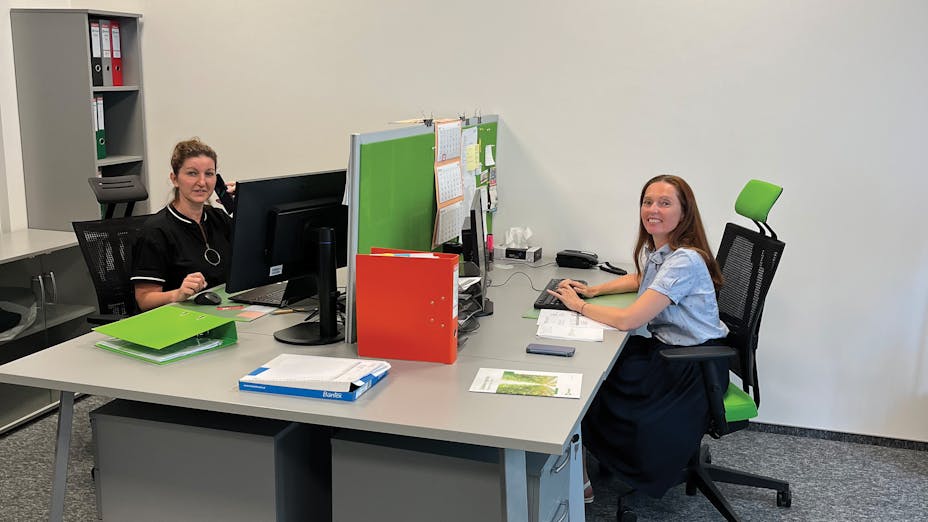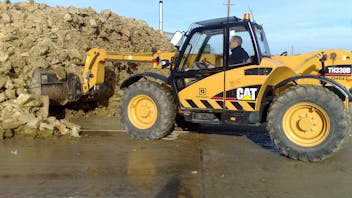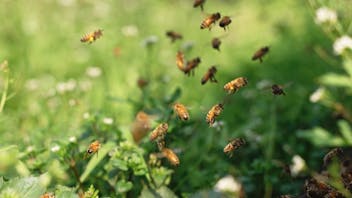Production and transport planning
That deliveries run smoothly and without disruptions is ensured by a team led by Robert Prządak, head of Supply Chain CEE&Ex (Supply Chain Division for Central and Eastern Europe and Export). Robert’s responsibilities, however, are much broader than just the logistics of finished products. His responsibilities include coordinating the production of Grodan products, ensuring timely deliveries and proper quality of growing media, as well as managing the storage and distribution process. The team leader himself describes his role as a liaison between Grodan, i.e. the purchaser, and the factory, i.e. the manufacturer. He is the first and the primary contact person between Grodan and Rockwool. The peak of the logistics season is usually at the end of the calendar year, but a busy period for the Supply Chain department starts as early as the middle of the year. Then, it is planned how to ensure supplies and production, conclude contracts with warehouses and provide necessary means of transportation. Robert says that these are routine activities carried out every year, which ensure that the company is able to fulfil orders according to our customers’ requirements. When asked what would make the job easier, Robert invariably replies that this would be timely orders from customers. They would enable production as well as all storage and transport activities to be planned very precisely. It is not a good idea to rely only on data from previous years when schedules are prepared. Better results can be achieved with current orders and by carrying out a proper market analysis together with the sales department. This greatly facilitates Robert and his team’s work and, most importantly, helps to secure the availability of the products required by growers.

Part of the Supply Chain CEE&E team (from left): Monika Wojnarowska, Anna Olak, Robert Prządak and Anna Masalska
Ideally, the products produced at the factory should be delivered directly from the production line to the greenhouse. Unfortunately, this is not viable, since demand exceeds production capacities in the season. To ensure that orders and deliveries are fulfilled properly, products must be manufactured in advance and stored. To prepare an adequate level of stocks, the company has more than 15,000 m2 of warehouse space. However, a number like that turns out to be insufficient during the peak season. For this reason, the so-called seasonal outdoor storage facilities are organised every year, where a buffer of several thousand pallets of growing slabs and blocks is accumulated. Locating additional warehouses closer to greenhouse growing regions significantly improves the subsequent distribution process to customers. A measurable assessment of the supply chain department’s performance is timely production and deliveries. Orders specify delivery times in on a weekly basis, but carries are notified for a specific day. This makes recipients’ work easier. For this reason, Grodan is very meticulous about ensuring timely deliveries. Monthly reports list all transport orders and resulting delays. Current performance of the team is very good. Since the beginning of the year, with over a thousand shipments, statistically 99.1% of deliveries have been carried out as planned. The main cause of the resulting delays was delayed pick-ups, which unfortunately are difficult to avoid.
The International Supply Chain CEE&Ex team of:
- Anna Olak responsible for deliveries to Japan, New Zealand and the Middle East,
- Iryna Parkhomchuk, who looks after deliveries to Australia, Singapore and the Commonwealth of Independent States,
- Hugo Garcia-Teruel Sanmiquel, who takes care of deliveries to Korea, Spain and South America,
- Monika Wojnarowska, who organises shipments to southern Europe and the Baltic countries and supports the domestic market,
- Anna Masalska, who is responsible for the domestic market as well as the Czech Republic
Precision of orders is important
Hygiene protocol is a basis
A growing medium that has already arrived at a particular greenhouse company cannot return to the Grodan depot. This principle stems from the hygiene protocol used against viruses and bacteria that infect crops. If a substrate that is ordered, produced and delivered to a farm is not accepted for any reason, it must be disposed of. This means that, once a delivery has started, any mistakes in the order can prove very costly. Colleagues in the supply chain team are aware of the nature of the greenhouse industry and know that changes to the ordered substrate are sometimes necessary and must be made. However, they stress that this concerns standard products and any changes can be made no later than ten days before the scheduled shipment. During the peak of a season, it is additional work and stress to change even a single order, since each change requires arrangements with multiple people in production, warehouse and transport systems. In practice, a minor change requires as much work as a new order.
In the case of non-standard slabs or blocks already produced for a specific grower, the order cannot be changed. Then, the shipment can only be disposed of and the full cost of the order must be covered by the party that made the mistake.
On the day of loading a vehicle, the recipient receives a message from Track&Trace system or an e-mail (or a text message) directly from the Grodan office with information on the time of delivery and its contents, with details of the vehicle and driver. Notifying recipients of deliveries enables them to prepare for receiving and unloading the vehicle, which is why this way of organising deliveries is praised by customers.
At the delivery stage
Responsibilities throughout the year
Preparations for the new greenhouse season and the associated logistics peak fall in the fourth quarter of the year, so it may seem that the first half of the year is a time of leisure for the Supply Chain CEE&Ex team. Colleagues do not like such am humorous opinion. Their year-round responsibilities also include controlling invoices and payments, and controlling and determining stock levels, as well as coordinating deliveries between Rockwool factories and deliveries between warehouses. Members of the SC team participate in various projects to improve their work (e.g. BigOrder Project), collaborate and train together with the delivery departments of Grodan’s partners, develop delivery and claims process schemes, as well as have many other responsibilities aimed at improving the efficiency of order and delivery handling. Also, the principle always holds true that a well-planned and prepared season will not be bringing unpleasant surprises.









